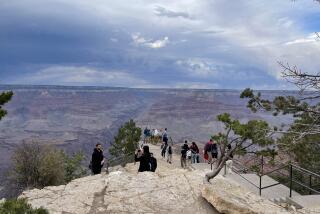Stuck and hungry at the Grand Canyon
Patrick Dotson was in crisis mode. The Grand Canyon Community Church pastor had just emailed a state food bank with an unlikely request: Rush food to one of the worldâs seven natural wonders.
Then came the knock on the door. A U.S. Park Service ranger asked whether Dotson could expand the small food pantry that was being run out of the churchâs garage. âHe said, âWeâve got families struggling here. How can we make this bigger?ââ Dotson said.
The U.S. government shutdown has turned a prestigious national park where millions come each year to relax and recreate into a realm of high anxiety. Hundreds of employees are stranded without work or pay, prompting the donation of hundreds of boxes of food for families that have nowhere else to turn.
About 2,200 people remain inside the isolated Arizona park, 1,800 of them employees of private concessions that make the place run â the people who change the hotel room sheets, serve the meals, sell the gift shop mementos. Many are entry-level, minimum-wage workers with families who live paycheck to paycheck.
And while concessionaires are offering free rent and meals to those out of work, dependents often do not qualify. Families who rent apartments and send their children to a school near the parkâs famous South Rim have been left to their own devices, forced to rely on savings and fast-emptying supplies.
The result: Dotsonâs food pantry, which normally serves a dozen families a year, now has its hands full. The impromptu pantry has been moved to a community hall, where volunteers distribute boxes containing rice, beans, peanut butter and tuna.
Dotson requested the assistance of Phoenix-based St. Maryâs Food Bank last week when he noticed that donated food at the church was quickly disappearing. He knew things would worsen as Washingtonâs standoff dragged on.
Wednesday brought news that future handouts would contain perishable items such as lettuce and other vegetables, sending a buzz through the park, said Sarah Stuckey, a spokeswoman for St. Maryâs.
âItâs just a very strange situation for all of us inside the park,â Dotson said. âThereâs a lot of nervousness here. People are worried. Theyâre asking, âHow long is this going to last?ââ
Along with uncertainty comes anger. In a busy fall season when the canyon is normally teeming with hikers and sightseers, the national treasure remains eerily empty, save for employees and the protesters who have gathered at its closed-off boundaries.
About 4.5 million tourists visit the Grand Canyon annually, pumping more than $1 million a day into nearby community businesses. The National Park Serviceâs 2,200 federal and private employees are not reporting to work. Tourists who drive to the park are turned away at the gate.
A National Park Service website with the logo âExperience Your Americaâ announced that âbecause of the federal government shutdown, all national parks are closed and National Park Service Web pages are not operating.â One Grand Canyon biologistâs voice mail announced: âIâve been furloughed. I cannot check phone messages until the government reopens.â
Meanwhile, activists waved signs reading âAmerica is better than thisâ and âTear down the Barack-cades.â A crowd this week confronted park Supt. Dave Uberuaga, who said only Congress had the power to reopen the parkâs gates.
The angst isnât limited to parkgoers. Concessionaires say they also feel abandoned by Washington.
The National Parks Hospitality Assn., an industry lobbying group, this week called for an end to the shutdown.
âThis shutdown victimizes the American people and the businesses helping our economy to grow,â read a memo sent to U.S. lawmakers. âThe inability to resolve issues in Washington is imposing pain on the rest of the nation. That inability needs to end â now.â
Spokesman Derrick Crandall said national park concessionaires had laid off 5,000 workers nationwide. âWeâre losing $5 million a day, with no end in sight,â he said. âThe government has shut off our revenue.â
He said concessionaires had been left to pay Washingtonâs bills because contracts required the businesses to keep buildings open despite the shutdown, and also to pay for utilities.
âWeâre subsidizing the federal government â how crazy is that? We canât shut off the lights and walk away. We have to be inside these buildings, even though tourists canât get to them,â he said. âYou can get interruption insurance for earthquakes and fires, but just try to get it for government shutdowns.
âEven Lloyds of London doesnât offer it. Who could predict such a thing?â
Xanterra, the Grand Canyonâs largest concessionaire, claims losses of $1 million a day across the West. Forever Resorts, which runs the concessionaire on the Grand Canyonâs North Rim, claims losses of $250,000 each day of the shutdown, half of its daily sales.
âThe Grand Canyon is closed completely and thereâs not a nickel going in there in terms of revenue,â said Bruce Brossman, Arizona regional director of sales and marketing for Xanterra, which has 1,300 employees at the park. âFor a lot of our people, theyâd be really stressed if you took half their hours away. So imagine taking all their hours. People need their savings and the food theyâve stashed away. This is extreme.â
The other day, Dotson drove food bank workers from Phoenix to the Grand Canyonâs South Rim.
âLast Monday, this park was what it always is â a bustling international center for people coming to see one of the most beautiful places in the world,â he said. âNow itâs a ghost town.â
Stuckey was on that tour. âIt was amazing to be alone at a place normally packed with people â to have it to yourself,â she said. âThen I realized how many families are suffering. That made it bittersweet.â
More to Read
Sign up for Essential California
The most important California stories and recommendations in your inbox every morning.
You may occasionally receive promotional content from the Los Angeles Times.











